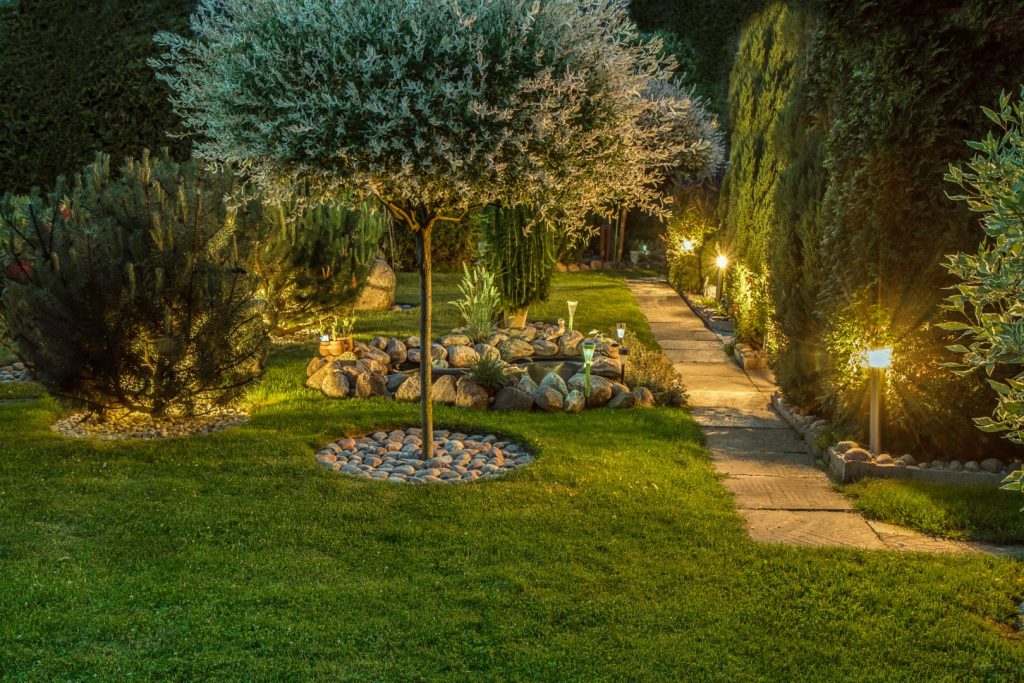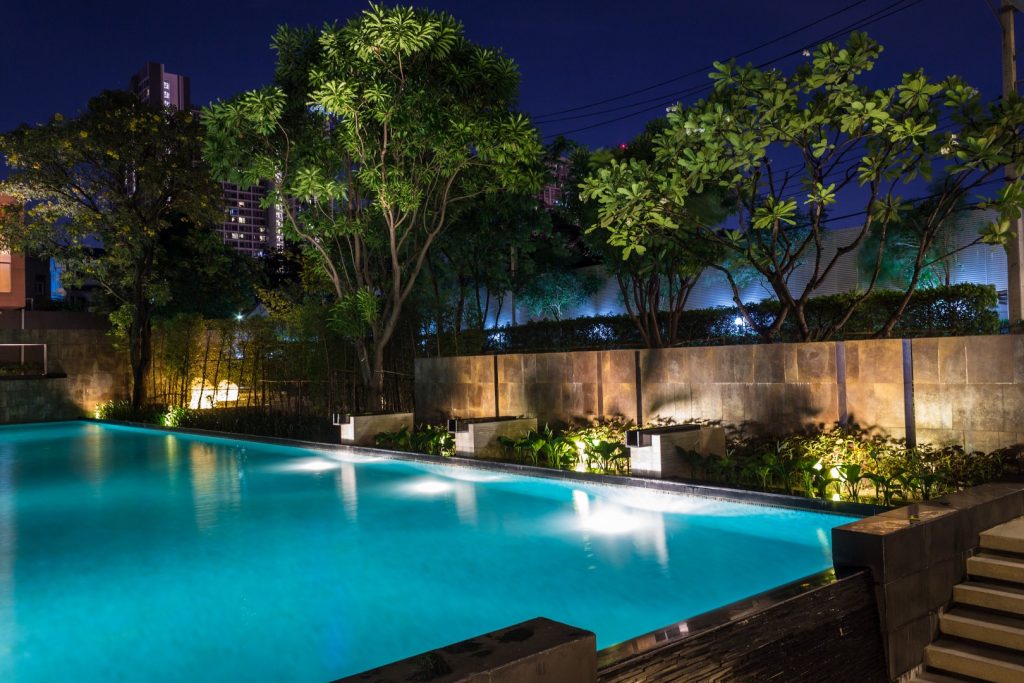The right landscape lighting enhances the beauty of your surroundings and increases your home’s value. It won’t only highlight your property’s best features; it can also improve your home security. However, not all landscape lighting are created the same. Experts from Washington Outdoor Lighting can help you choose which options best suit your specific needs.
Before you start browsing catalogs or going to home improvement stores, there are essential factors you should take into consideration. Below are some of them:

Private garden in the evening, illuminated by lamps
When choosing landscape lighting, you’ll need to come up with a realistic budget. Refrain from whipping out your credit card if you haven’t finalized your budget yet. A budget will help guide your choices later on. After all, you don’t want to spend more than you can afford.
If you think purchasing lighting kits is the best decision, better think twice. Most kits are subpar and easily fade, break, and degrade. The lights are also not as effective as the manufacturers claim. Check the quality and grade of your preferred landscape lighting if you don’t want to end up wasting your time and money. If you’re looking for quality options that are easy on the pocket, check out Washington Outdoor Lighting Youtube Channel for more information.
There are two primary options when looking at what type of lighting bulbs for your landscape lighting needs. While most people prefer halogen bulbs, others choose more energy-efficient LEDs.
When lighting up your garden, remember that the best landscape lighting is known for its superior performance in terms of reliability and consistency. It must have multiple beam angles, high efficiency optics, full-definition, no color separation, no hot spots, not sharp edges, and so on. Other than performance, they should have a good water resistance rating to withstand any harsh climate conditions year-round.
You need to invest in quality transformers for your landscape lighting. There are several considerations when picking a transformer. One of these is the wattage. You should know the number of lights that can be safely added to your transformer. With this, you’ll be able to extend the life of your transformer.
Another thing to consider when choosing a transformer is its capability. There are transformers that run on a timer while some operate on a light-sensing photocell. Depending on the unit you choose, you may program your landscape lighting to turn off or on, or fade at particular times.
There are various types of landscape lighting you should get familiar with when you’re checking out your options. Some of these include the following:
On the other hand, floodlights have a wider beam spread, which can be up to 120 degrees. If you want to cast light over general areas like a lot or driveway, use floodlights. It’s perfect for overall visibility and safety.
If you have enough room in your budget, go with a low voltage LED. They can be expensive, but these lighting fixtures last the longest. You can also use a low voltage transformer to power them.
Every lighting fixture comes with a UL rating that’s based on its ability to withstand the elements. UL stands for Underwriters Laboratories, which is a product safety certification company which tests the products to ensure that they meet the standard safety requirements. UL ratings help buyers determine if the lighting fixture is safe for indoor or outdoor use.

Lighting business for luxury backyard swimming pool. Relaxed lifestyle with contemporary design by professionals.
When deciding on the best landscape lighting for you, it’s crucial that you know what you’re buying. A fixture that is damp rated can be used in covered outdoor areas, such as the lighting you use for your covered porch. The fixture may be exposed to dampness. On the other hand, wet rated lighting fixtures can be exposed to the elements. You can safely use them outside and they’re also suitable for uncovered outdoor areas.
Is your property classic and elegant? Is it contemporary or minimalist? If you’re not sure about what style of lighting goes best with your home’s architecture, try out the following:
When choosing landscape lighting, make sure to read up on the state and local regulations for installing landscape lighting fixtures. Some states may require lighting fixtures that are Dark Sky certified or energy efficient to lessen light pollution. There might also be specific local legal restrictions or guidelines you need to follow. Research about these requirements before making your choice.
Another essential aspect to consider is the type of material your lighting fixture is made of. Some of the usual types of materials used in manufacturing lighting fixture are stainless steel, copper, brass, aluminum, and plastic. When choosing which option best suits your home, think about the weather patterns and general humidity level in your area, your landscaping or gardening habits, and your long-term expectations.
Here are some of the features of the top lighting fixture materials in the market today:
The only downside is copper turns green over time because of the weather. But it does offer protection from rust and corrosion. Often, copper is used for coating others metals like brass to provide added protection. Another consideration to remember is that machined copper costs more but offers better quality than the stamped or rolled variants. If you’re looking for strong and long-lasting lighting fixtures, it’s definitely worth a try.
Grade 316 stainless steel tend to be more resistant to corrosion. However, such fixtures might not be suitable if you’re living near the coast or around highly humid areas. Moreover, stainless steel fixtures require constant cleaning and maintenance to reduce discoloration or corrosion and to keep their shiny look.
One of the best decisions you’ll make when you’re planning to install landscape lighting is hiring lighting experts to assist you. With their knowledge and expertise on landscape lighting, they can suggestions or recommendations to ensure the best possible outcomes for your home.
Choose experts who have been in the industry for years and have worked with many clients before. In this way, you are more confident you’re in the right hands and you won’t get steered into the wrong direction.
Bottom Line
Choosing landscape lighting may be confusing and challenging, especially if you’re surrounded by a lot of amazing options. However, by keeping the considerations above in mind, you’ll sure to get the lighting options that meet your unique needs or preferences.
Just take note that the best landscape lighting is not always the most expensive one, but the one that’s made with quality in mind. Moreover, it’s a good idea to get the assistance of experts who have knowledge and experience in landscape lighting to get the most out of your investment.